Admirer of Croatian history Tocher Mitchell (SME Finance Specialist) takes you on a journey of castle and fortress ruins in the Zagreb County.
Croatia is dotted with hundreds of medieval castles, some intact but most in various stages of ruin. The area surrounding Zagreb is no exception. You don’t have to travel far to find them – some are right in the outskirts of the city. The history behind the castles is captivating. Originally, they were built as redoubts against the Tartars (Mongols). Later most were expanded and refortified to defend against the Ottoman Turks. By the 17th century, advances in military technology had rendered castle fortresses obsolete. Besides, noble ladies by that time were refusing to live in cold, drafty, isolated, stone castles or forts. Those that weren’t destroyed in battle were abandoned and fell into ruin. But exploring these ruins is pleasurable and fascinating. As they usually were built on hill or mountain tops, the views and the architecture can be spectacular. And wandering through them conjures up visions of what might have transpired there over the centuries.
There are three castle ruins on the slopes of the Medvednica mountain range (literally translated, “Bear mountain”) just north of Zagreb. Two of those castles are in the city of Zagreb itself. Medvedgrad is clearly visible from downtown about a third of way up the slopes of Sljeme Mountain. To reach the castle drive or take bus No 102, which runs between Britanski trg and Mihaljevac, and get off at the “Blue Church” in Šestine. Take the paved road that runs up past the church cemetery towards the mountain. After you pass a restaurant on the right hand side of the road if you are walking look for trail No 12 going up into the forest on the left side of the road. The hike up from the bus stop takes 35 – 45 minutes and is moderately steep in places. You can also drive to the castle in about ten minutes on the paved road. There is a café in the restored section of the castle. The view of Zagreb to the south and west is very good. Also, in front of the castle check out the somewhat incongruous modern monument and eternal flame dedicated to fallen Croatian soldiers.
Medvedgrad has a colorful, checkered history. Zagreb’s Bishop Filip built the fortress in the 13th century, after King Béla IV granted him a deed authorising its construction. The fortress had great strategic significance. It could be easily defended during times of war, and it was situated near the western border of the Hungarian-Croatian state. During the seven centuries after its construction, Medvedgrad had many owners. Until the 16th century, it was owned by several distinguished, noble families and individuals, such as Bela IV, Drašković, Gregorijanec, Radić, Zrinski, Andrija III, Zagreb Kaptol and King Matijaš Korvin.
Béla IV was a key figure in Croatian and Hungarian medieval history. He was king from 1235 – 1270, the period during which the Mongols first invaded the area. Aware of the threat they posed, Béla tried to mobilize the troops of other nobles and magnates, and he sent messages asking for help to Pope Gregory IX and the Holy Roman Emperor Frederick II, but to no avail. The Mongols eventually routed Béla's army in the Battle of Mohi on April 11, 1241. It was only a year later that the Mongols withdrew upon the death of their Great Khan, Ogodei, son of Ghengis Khan. Béla reoccupied his kingdom and undertook a massive construction campaign. It was this campaign that produced many of the castle fortresses designed to defend against another, possible Mongol invasion. Many of the ruins we can see in Croatia today are of castles built during this time.
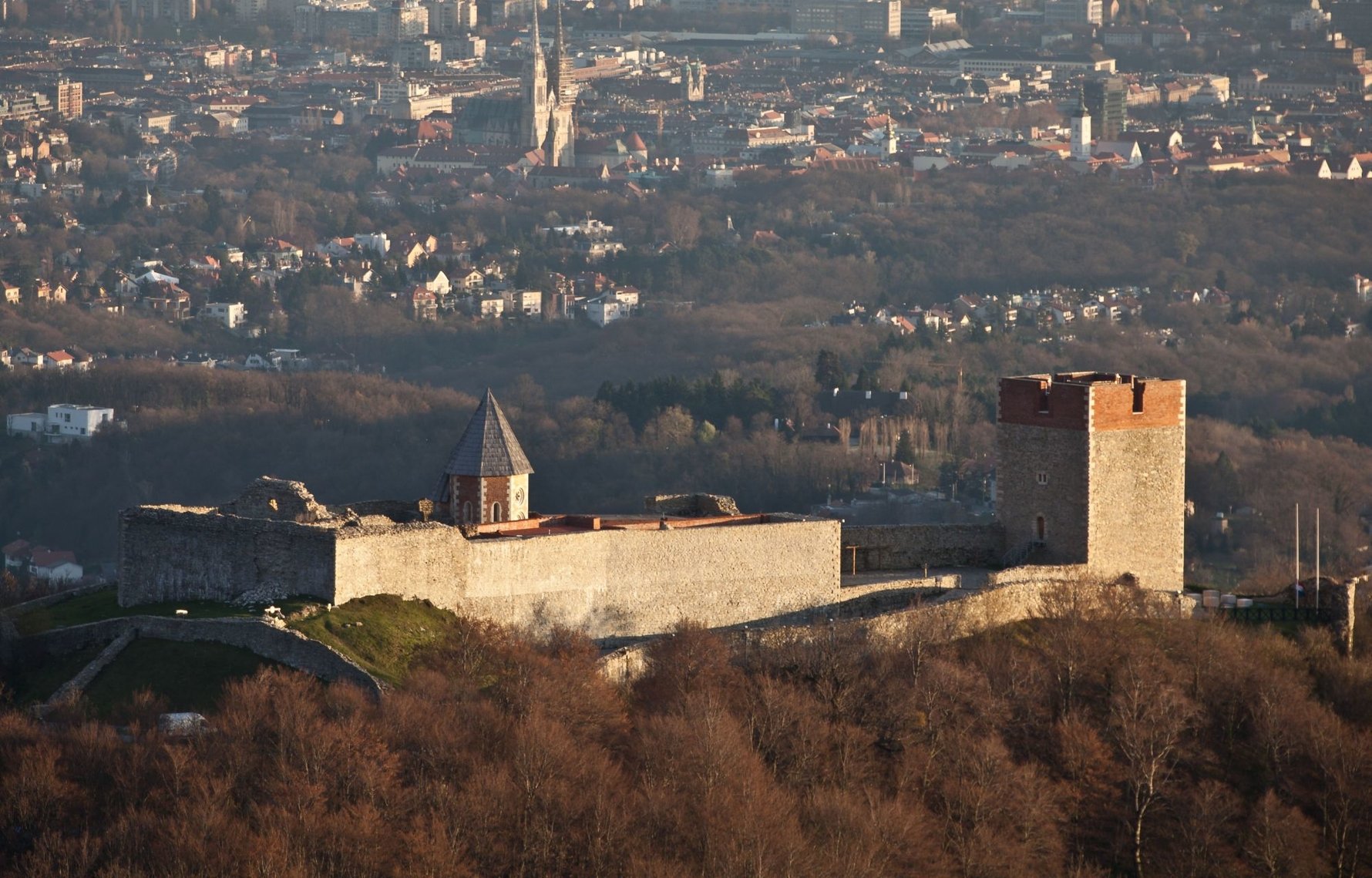
Medvednica Nature Park Archives
Susedgrad is the second castle ruin in the city of Zagreb. It’s situated on the western edge of Zagreb on a low hill, in an area appropriately called “Podsused” (literally translated, “Beneath Sused”). The remains of the castle are visible from the Zagreb – Maribor highway through thick woods, but only in winter, when there is less foliage. Susedgrad is 12 km (7.5 miles) west of the main square, Trg bana Josipa Jelačića. To reach it simply follow Ilica, the main east-west avenue. There are several city buses that go to Podsused from Črnomerec, which is the western terminus of trams 2, 6 and 11. Once you reach Podsused you should turn right off the highway right before a VW dealer. Behind the dealer a marked trail begins. The trail winds up through a wooded park. The ascent only takes around 10 – 15 minutes. There is a good view of the Sava River just below the cliff, close enough that you can hear the noise of the rapids. On a clear day one can see the Samobor Mountains and perhaps even the Slovenian Alps. There is not much left of the ruins, just some walls and what looks like a moat. Nonetheless they are interesting to explore and their proximity to the center of Zagreb makes them an attractive jaunt for a couple of hours.
Susedgrad was probably built in the 13th century as a fortress on the road from Slovenia to Croatia. There might have been a boat crossing at that point on the Sava River. Susedgrad figured in the peasants' rebellion of 1573, when the castle's owner was Franjo Tahi. After yet another peasants' rebellion, the castle was destroyed during fighting. By the end of 17th century it lay in ruins.
Zelingrad is the third castle ruin on the slopes of Medvednica. It is only around 35 km (23 miles) from the center of Zagreb. The easiest way to reach it is to take the highway from Zagreb towards Varaždin and exit at Sveti Ivan Zelina. As you approach the town center, turn left on Zelingradska ulica just after a Konzum warehouse. Stay on that road for several kilometers until you reach a gated, dirt road on the right. There is a sign that says “Zelingrad”. It is possible to drive all the way to the castle, which is advisable if the road is dry, because on a weekend especially there are enough vehicles to create a lot of dust, which makes walking not very pleasant. If you do walk it is a gentle, 45 minutes ascent from the gate to the castle ruins through a thick forest. At a fork in the road just past an abandoned building, take the left fork (go straight).
The ruins are nearly enveloped by the surrounding woods, so there are no views. Zelingrad was probably built in the 13th century. It was first mentioned in written records in 1295. In 1640, it was already mentioned as a ruin.
Although Medvedgrad, Susedgrad and Zelingrad are the only castles visible today in the range, in fact throughout the Middle Ages slopes of Medvednica were dotted with a number of additional, fortified castles. All that is known now is where the other castles and fortifications once stood. In many instances there is nothing left because people took stones from the ruined castles to construct other buildings or walls.
There are several other castle ruins worthy of exploration in Zagreb County. Spectacular Okić Castle is located around 30 kilometers (20 miles) west of Zagreb. It is clearly visible from afar, perched at the top of a steep sided hill. You can reach Okić from Zagreb by taking a two lane road that starts in Lučko, just before the tollbooth on the highway leading to Karlovac and Split. That road parallels the highway. Proceed north of Jastrebarsko to the village of Novo Selo Okićko (“New Village of Okić”). A marked (white circles with red centers, like a small target) trail begins there. There are several other trails to Okić that begin from other, nearby villages, including Okić, but the hike from Novo Selo is the most pleasant and varied, going through some forests, some lily of the valley beds, apple orchards and meadows. A couple of streams must be crossed (on stepping stones). The hike takes 45 minutes to an hour. If you are into thrills the upper half of the trail from Okić village scales a nearly vertical cliff. Be sure to hang on tight to the metal rungs and ladders! From the castle there are incredibly beautiful views in all directions, including Zagreb and Medvednica.
The equally spectacular ruins of Samobor Castle are perched on a hill right above the town of Samobor, which is only around 25 kilometers (15.5 miles) west of Zagreb. To reach the castle take the Zagreb – Ljubljana highway, get off at the Samobor exit and follow the road with concrete surface towards Samobor, taking the left fork into that town. Proceed right through the town center and start walking up from the park on the west edge of town (you can see the ruins immediately above). It is only about a 10 – 15 minutes ascent on a switchback trail. As of this writing there was a locked gate at the main entrance to the ruins, but you could still easily gain access by walking around to the rear. One wonders why the authorities bothered with a gate at all. There are lots of good cafes and restaurants in the town of Samobor.
By the charter of King Béla IV in 1242, the town of Samobor was granted the privileges of a free market town. The castle was built around the same time, and various additions and renovations were made over the next 500 years. The castle was owned by a number of eminent families: the Babonić, Counts Celjski, the Frankopans, the Ungnads, the Erdodys, the Kulmers, the Kiepachs, and the Allnochs. Samobor castle was abandoned in the 19th century. After that it gradually fell into ruins.
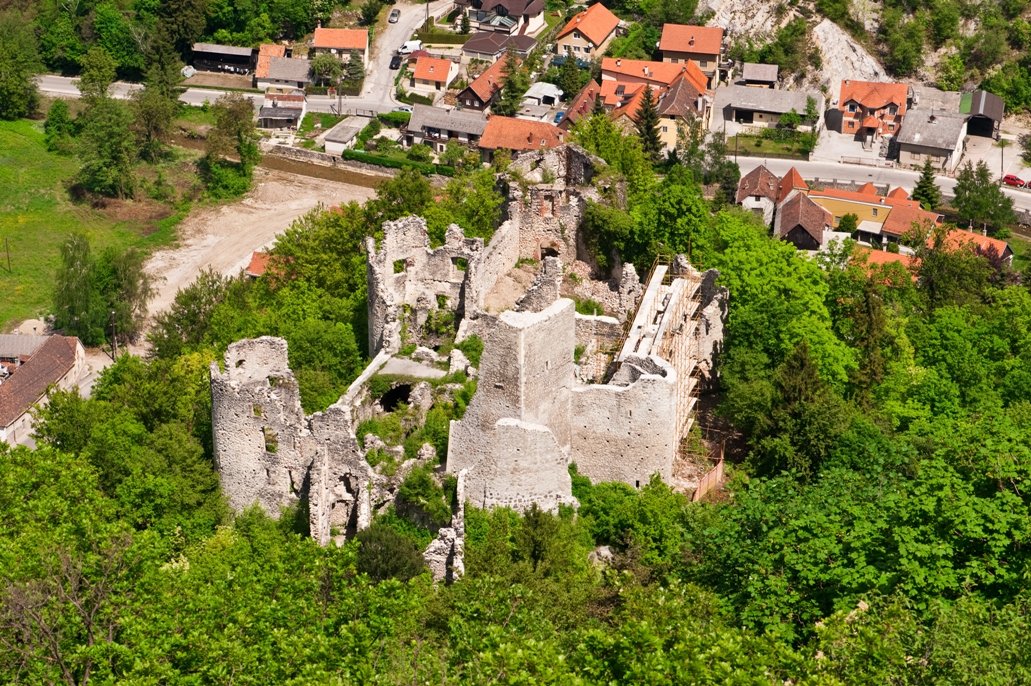
Shutterstock Old Town Samobor
The ruins of Lipovec Castle are quite close to Samobor. The trailhead to Lipovec is 7 km. Past the traffic light on the west side of Samobor town. Not clearly marked, the trailhead is opposite a restaurant. The ascent takes around 20-25 minutes and is quite steep.The site is relatively small but interesting to explore.There are no views as the ruins are surrounded by thick forest. The history of Lipovec is closely connected with Okić. It was built in 1251 by one Ivan of Okić, but by 1618 it was already mentioned as a ruin.
Starigrad Žumberak is a partially restored castle ruin located amongst rugged hills northwest of Zagreb near the border between Croatia and Slovenia. One can reach the ruins by taking the main Zagreb – Karlovac highway, taking the first exit, Jastrebarsko. Continue southwest (towards Karlovac) on the secondary road that parallels the highway. Turn north (right) on another secondary road at Vrh. Continue on that road – it will link up with Route 505, on which you continue north. Route 505 winds up hill and down dale, with many vivid views. There are watermills in the area, unique to Croatia, as well as picturesque old wooden houses.
Right after you see a sign indicating the entrance to Žumberak Nature Park, there is a dirt road leading to the west (left), with a sign pointing the way to Starigrad Žumberak. Continue on that road through the village of Tomaševci. Just after that village there is a much rougher dirt road descending to the left. Unless you have an SUV or a desire to wreck your compact car it’s better to walk, which in any case is a pleasant hike to the ruins. There is a small sign at the fork. It takes about an hour to walk from the fork in the road to the ruins. You pass through the remote, picturesque village of Starigrad Žumberak on the way. If you drive all the way it takes about an hour and a half to drive from the center of Zagreb to Starigrad Žumberak. There are no services in the village.
This hike is attractive because of the beautiful, quaint scenery. There really is not much left of the ruins, which lie about a kilometer past and above the village. Currently the ruins are undergoing restoration.
In the 13th century Grad Žumberak belonged to the Carinthian dukes. After the inward immigration of the Uskoks (1530) it was the headquarters of Uskok captains. The Uskoks were fierce, guerilla fighters who fought against the Turks after being driven from their homes in what is now Bosnia & Herzegovina. The rugged terrain surrounding the castle is perfect for ambushes. Given this history, it’s probably a good idea to be deferential to the local villagers. The castle was known in German records as Sichelburgh. It was gutted in a 1793 fire.
There are several other castle or fortress ruins in Zagreb County, but those detailed above are the most interesting and scenic. One would hope for posterity’s sake that more of them can be restored or least stabilized. They are so rich in history, mystique, architecture and heritage.


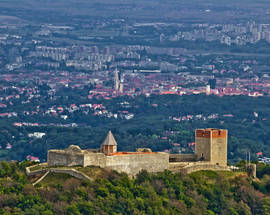
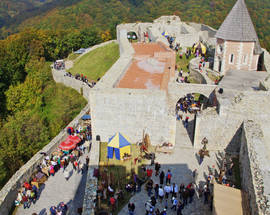
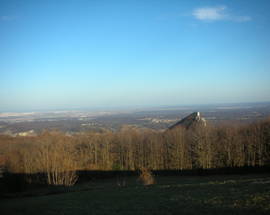
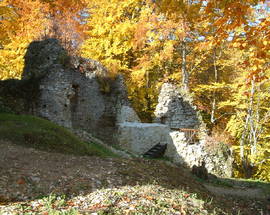



Comments